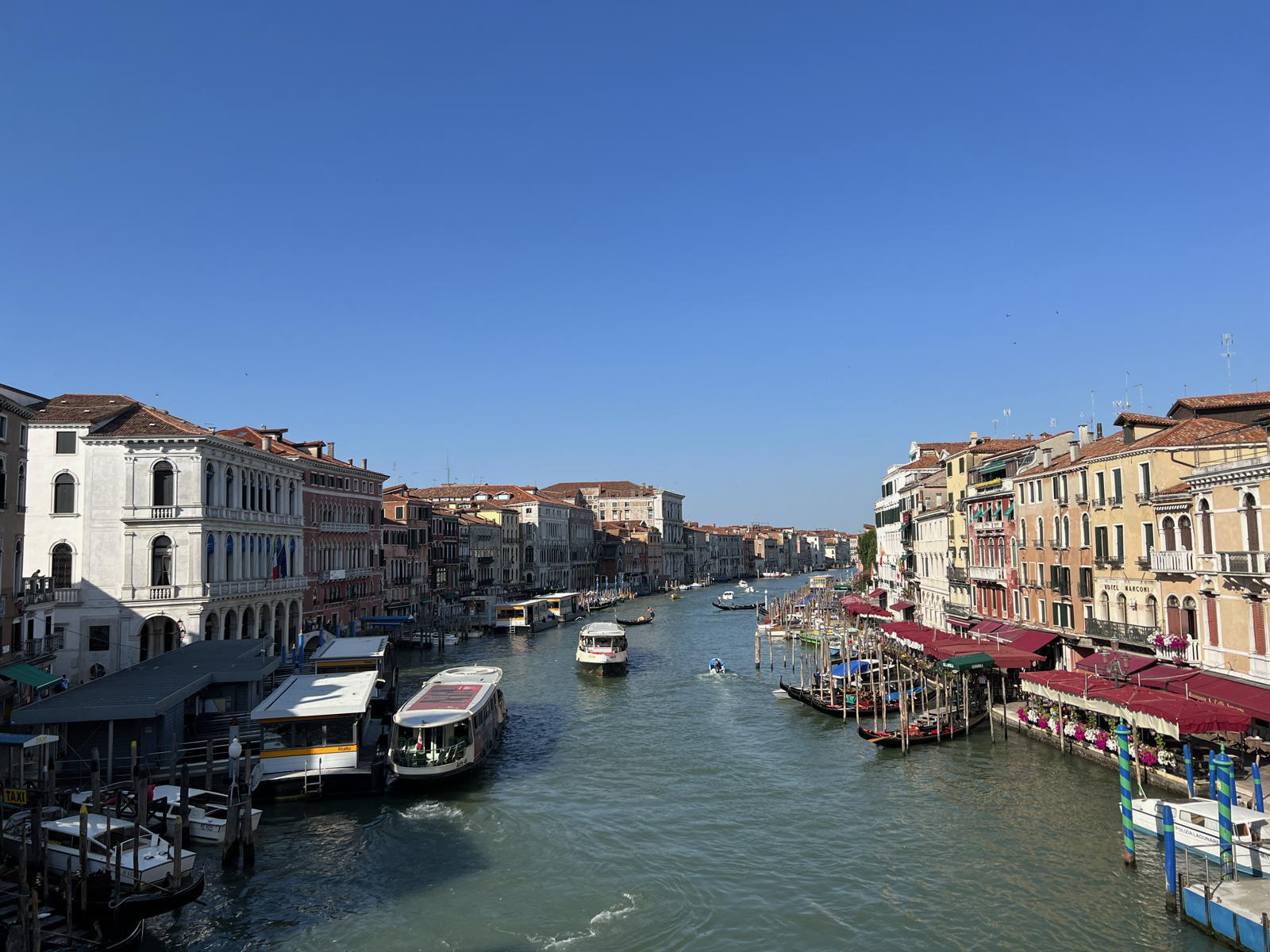Italian road safety campaign social media backfire
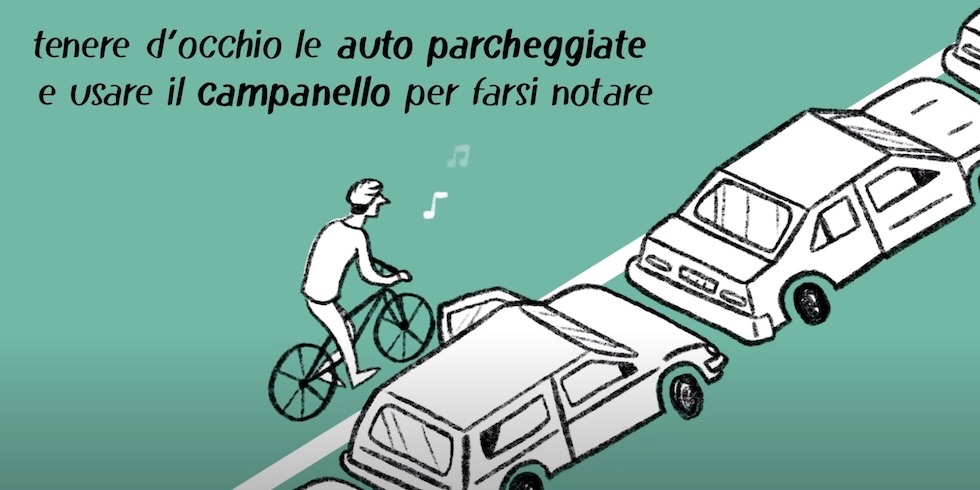
Translation: “Keep an eye on parked cars, and use your bell to be noticed.” This should not be controversial, although I might quibble with the bell.
I’ve been reading Il Post lately, both to improve my very bad Italian and to gain a non-American, non-English perspective on the news of the day. Yet somehow I missed this article about a “scandal” in Lombardy until a friend brought it to my attention with the comment “This is funny.”
It is funny, and a very good example of why I avoid social media. In a virtual environment we lose any sense of reality. In this case, it appears that a local government was actually doing something substantive to keep pedestrians and bicyclists from being killed by inattentive drivers. It turned into a social media scandal because… it told people how to effectively stay alive rather than laying blame and letting them die!
I’m not going to translate the whole thing. It’s not worth the trouble and in any case my Italian is not up to the task. The title is The questionable campaign on street safety in Lombardy. The subtitle is:
È stata sospesa dopo molte critiche a un post che dava consigli ai pedoni per evitare di farsi investire, dando un po' l'impressione di colpevolizzarli
That is, in my rough Italian:
It [the safety program] was suspended after much criticism to a post that advised pedestrians on how to avoid getting hit, giving a bit of an impression of blaming them.
The thing is, that bit of blame is no more than saying that some pedestrians don’t pay attention to the possibility of dangerous drivers when using the street. I do a lot of walking when I travel, and this is demonstrably true. Judging from the campaign’s graphics, the campaign was not about assigning blame but about saving lives.
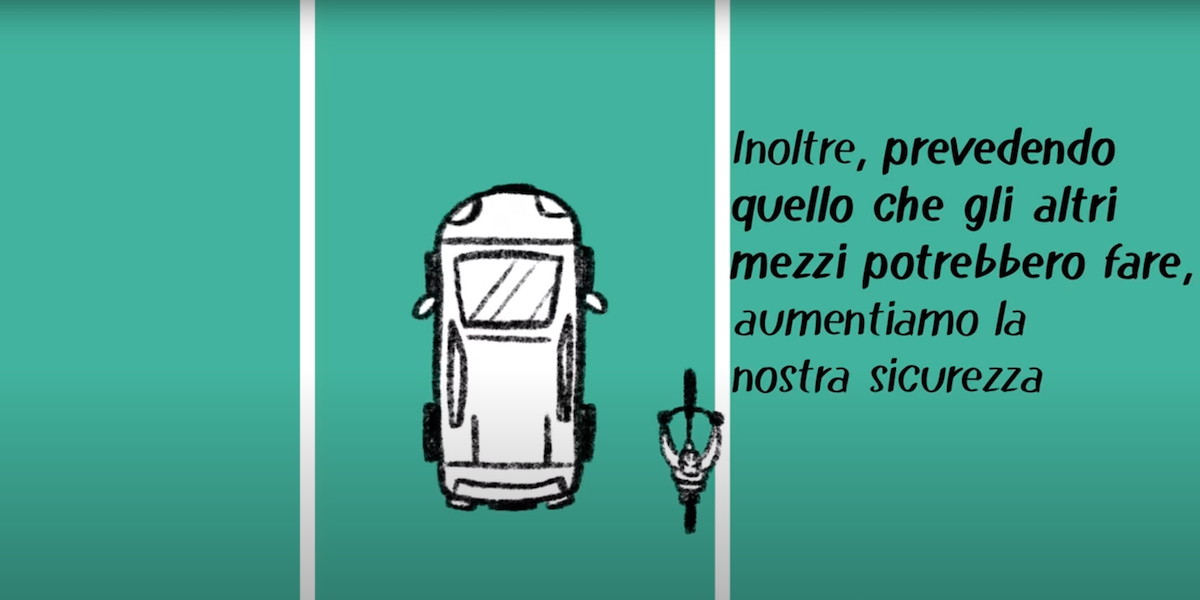
Translation: “Also, by watching for what others will do we improve our own safety.” Situational awareness is always a good idea.
There is a huge difference between blaming the victim and decreasing the probability of becoming a victim!
Are the people this campaign is aimed at in the wrong? No. A pedestrian is perfectly in the right to cross at a crosswalk without watching to see if traffic is actually stopping. Bicyclists are perfectly in the right to sail down the bicycle lane without watching for parked cars suddenly opening their doors.
But is that smart?
In a perfect world we wouldn’t have to pay attention when we’re in the right. In a perfect world we shouldn’t have to look both ways when crossing the street. In a perfect world we shouldn’t have to assume that one in ten or one in a hundred or one in a thousand motorists are paying attention to something other than us. But this is not a perfect world. Too many motorists, bicyclists, and pedestrians act as if it were. Too many people get angry when it’s suggested that there are simple ways to avoid the consequences of other people’s mistakes.
If I’m reading the bicycle advertisement correctly, all it says is to keep an eye out for parked cars when you’re on a bicycle path next to a parking lane. And make noise to help the drivers of parked cars notice you before they open their doors (or, presumably, pull out of the parking lane, but I don’t think that’s mentioned). This is very good advice. Just because you weren’t at fault doesn’t help you survive when a car door opens and tosses you into the street!
It isn’t the cyclist’s responsibility to watch for car doors about to open. But it’s the smart thing to do. I do a lot of walking. I used to do a lot of bicycling—literally every work day for about an hour and a half a day. Very few motorists drive dangerously. Very few motorists are oblivious to their surroundings. But it only takes one. It only takes one driver distracted by someone walking on the other side of the street, or distracted by traffic in another direction, or by a passenger, or by one of the many esoteric lights, dials, and meters that proliferate in modern vehicles.
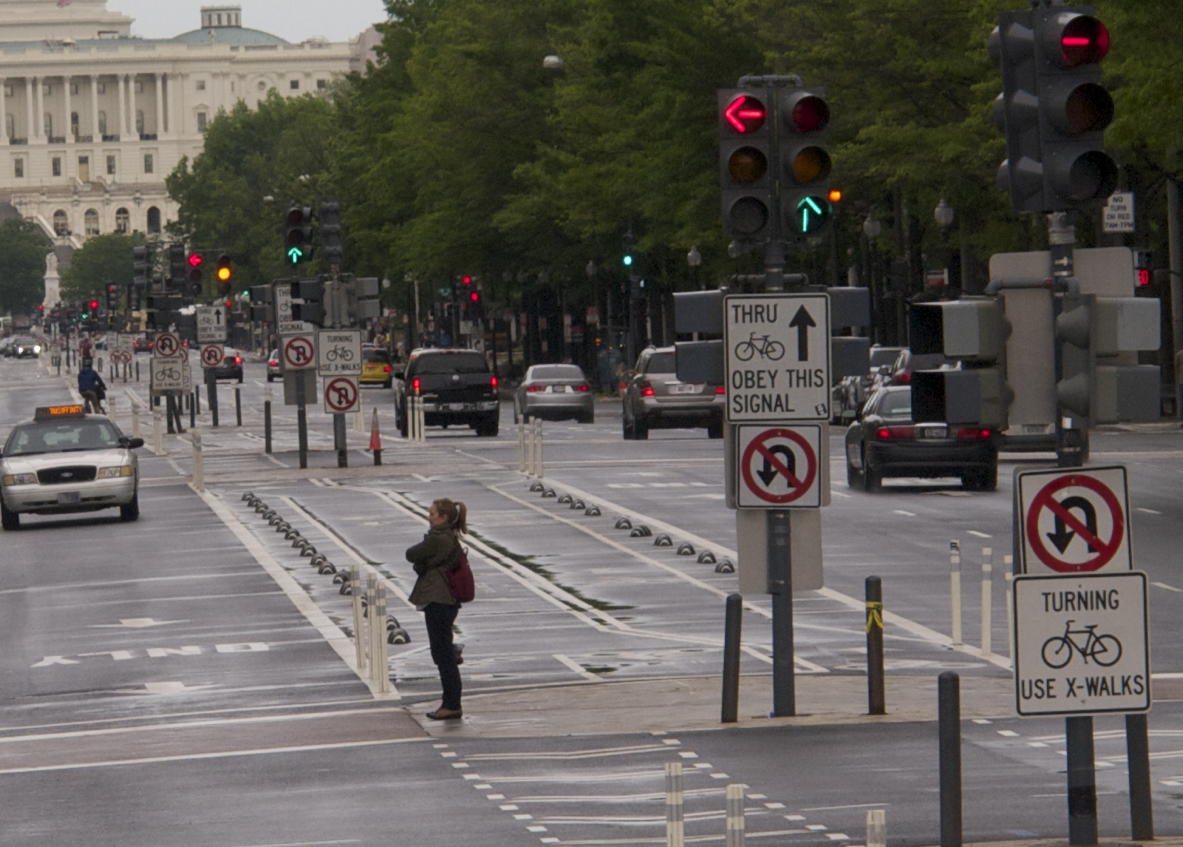
Pedestrian, bicyclist, or motorist, be careful where everyone else on the road is devoting their attention to reading road signs.
In a bicycle lane next to parked cars the cyclist could be passing hundreds if not thousands of parked cars. If the chance is one in a thousand and you take that route every day, the chances are pretty good you’re going to encounter a potentially dangerous situation a couple of times a year at least.
It is very easy to vastly reduce the probability of being the victim of that one motorist in a thousand who is, just at the moment you’re passing, distracted by something you can’t see. Especially in this world where distractions proliferate both outside the vehicle and increasingly inside the vehicle.
Advocating that cyclists maintain situational awareness near parked cars is not the same as saying that it is the cyclist’s responsibility to avoid getting tossed into the road. If a cyclist gets tossed into the road because someone opens a car door into them, or someone happens to be making a right turn just at the moment the cyclist is passing them on the right because that’s where the bicycle lane is, they are entirely not at fault, and the motorist is entirely at fault.
Fault doesn’t change either the likelihood of survival or the likelihood of a one-in-a-thousand accident happening, an accident that could have been avoided if the more vulnerable person was paying attention to the possibility that this is not a perfect world. In driving, this is called “defensive driving” and it’s generally considered a virtue. You can’t assume that everyone around you is driving at the top of their game.
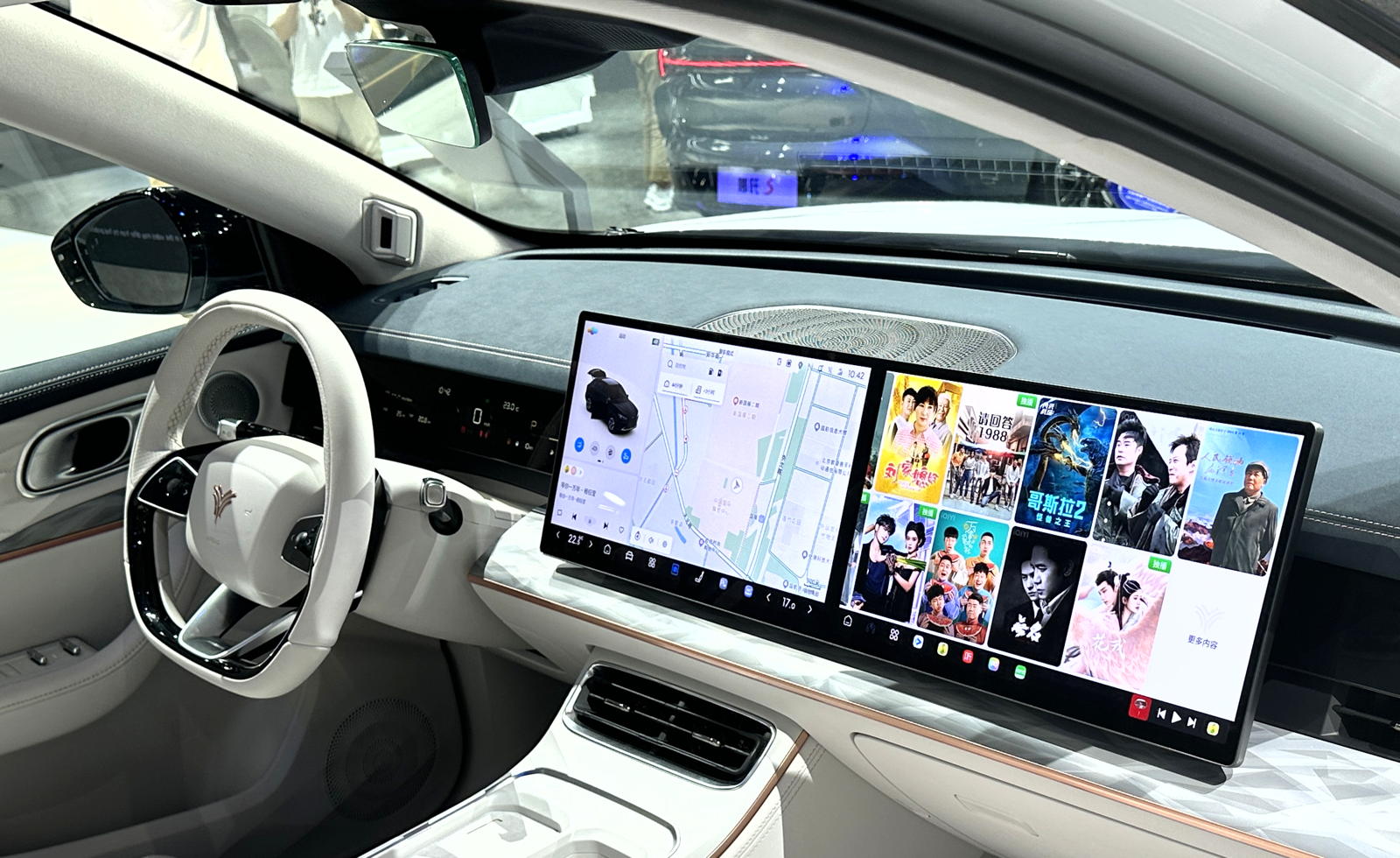
“The dashboard was full of esoteric lights and dials and meters that I would never understand.”—Hunter Thompson, Fear and Loathing in Las Vegas.
You shouldn’t suddenly assume that everyone is paying attention only to you when you’re on foot or on a bicycle.
There are things people can do to stay alive when someone else fails in their responsibilities, and that skill appears to be one that a significant number of pedestrians and cyclists do not have.
Don’t even get me started on bicycle lanes placed within range of opened car doors, or expecting cyclists to both go straight and potentially even make left turns from a lane that is to the right of the right turn lane. This is neither the fault of the cyclist nor of the driver, but of the idiots who don’t understand basic road safety.
What makes this worse is that it appears to be the view of the Post that if potential victims stay safe, there won’t be enough victims to pass more laws to restrict who can be out on the street. Here’s the Italian in case I’m messing up the translation and suffering an Emily Litella moment:
Nello stesso video si suggerisce anche ai ciclisti di fare attenzione agli angoli ciechi dei camion, cioè quei punti che lo sguardo dell’autista non riesce a raggiungere con gli specchietti, anche qui però senza che emerga con chiarezza chi ha le maggiori responsabilità: di recente proprio nel capoluogo lombardo, Milano, questo tema è stato al centro di un acceso dibattito per la proposta di limitare la circolazione dei mezzi pesanti sprovvisti di sensori per l’angolo cieco.
“In the same video it is suggested also to cyclists to pay attention to the blind spots of trucks.” The article then goes on to explain what a blind spot is! If Italian cyclists—and motorists?—do not know what a blind spot is, they definitely need this campaign. The article continues by saying that the suggestion to avoid blind spots was done “without saying clearly who has the major responsibility, a topic that was recently at the center of a heated debate about barring heavy vehicles that don’t have sensors in their blind spots.”
Of course cyclists should pay attention to the blind spots of other vehicles, just as every other user of the road should! We should all pay attention to other vehicles’ blind spots regardless of how that affects the ability to lobby for new laws barring delivery traffic from making deliveries. Especially when one of the consequences of their new laws will be even more esoteric technologies to distract the driver at just the wrong time.
The Post’s take seems to be that it’s more important to assign blame than to learn to live in the real world, whether as driver, cyclist, or pedestrian. And they’re not alone. Just about any time good ideas are proposed that help people rather than lay blame, the good ideas are denigrated in favor of laying blame. From providing just-expired food to food banks (expired food is good for weeks, if not years for packaged goods, past its expiration date) to literally keeping people from dying in the streets, helping people isn’t anywhere near as important as complaining about who isn’t doing enough or why the universe isn’t fair.
If there’s one thing astronomy teaches us, it is that the universe isn’t fair. But we can make our one tiny part of the universe better, and it usually isn’t even difficult.
In response to A one-hundred-percent rule for traffic laws: Laws should be set at the point at which we are willing and able to jail 100% of offenders. We should not make laws we are unwilling to enforce, nor where we encourage lawbreaking.
- Effective Cycling•: John Forester (paperback)
- “An essential handbook for cyclists from beginner to expert, whether daily commuters or weekend pleasure trippers. This [book] offers cyclists the information they need for riding a bicycle under all conditions: on congested city streets or winding mountain roads, day or night, rain or shine. It describes the sheer physical joy of cycling and provides the nuts-and-bolts details of how to choose a bicycle, maintain it, and use it in the most efficient manner.”
- La discutibile campagna sulla sicurezza stradale della Lombardia at Il Post
- “È stata sospesa dopo molte critiche a un post che dava consigli ai pedoni per evitare di farsi investire, dando un po' l'impressione di colpevolizzarli.”
- Requiem for a Heavyweight: John Schubert at Cycling Savvy
- “Sometimes, a well-intentioned intervention is far worse than leaving well enough alone. And that is just the beginning of what I learned from John Forester.”
- What About Bikeways?: John Forester at Cycling Savvy
- “The worst thing cycling is promoting is the bikeways movement… We used to have access to very nearly as much of a magnificent road system as we could ever use, and we are giving this up for permission to ride in Central Park…”
More traffic safety
- City Lights and Sensors Always Get Me Down
- If pilots have too much input to make safe decisions, should we be turning our automobile dashboards into cockpits?

